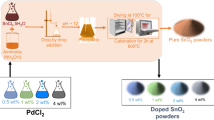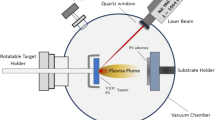Abstract
Different types of vanadium pentoxide nanostructures were fabricated by pulsed laser deposition and were studied as gas sensing materials to control selective catalytic reduction process. X-ray diffraction and Raman spectroscopy studies confirmed that the fabricated layers consisted solely of pure V2O5 phase. The film surface morphologies were examined by atomic force microscopy. The results showed that microstructures of the films were strongly dependent on the deposition parameters used in the pulsed laser deposition process. The morphologies of the film surfaces varied also between denser films and highly porous layers formed of agglomerated nanoparticles. The electrical conductivity-based gas sensing measurements showed strong selectivity to ammonia in comparison to NO and CO gases in the cross-sensitivity tests. The films were capable of detecting 20 ppm of NH3 even in the presence of the interfering gases of NO and CO, and also in varying O2 background concentrations. Furthermore, the films were found to show very stable gas response over the time period longer than 450 h. These are very promising results when considering possible sensing applications, e.g., control of selective catalytic reduction process in diesel engine exhausts with very strict and challenging specifications set by car industry.








Similar content being viewed by others
References
Koebel M, Elsener M, Kleemann M (2000) Urea-SCR: a promising technique to reduce NO x emissions from automotive diesel engines. Catal Today 59:335–345
Qiu T, Li X, Lei Y, Liu X, Zhang C, Feng X, Xu H (2015) The prediction of fuel injection quality using a NO x sensor for the on-board diagnosis of heavy-duty diesel engines with SCR systems. Fuel 141:192–199
Hofmann L, Rusch K, Fischer S, Lemire B (2004) Onboard emissions monitoring on a HD truck with an SCR system using NO x sensors. Paper presented at the SAE 2004 world congress & exhibition, SAE Technical Paper 2004-01-1290, Detroit, Mar 2004
Wang DY, Yao S, Shost M, Yoo J, Cabush D, Racine D (2009) Ammonia sensor for close-loop SCR control. SAE Int J Passeng Cars-Electron Electr Syst 1:323–333
Herman A, Wu MC, Cabush D, Shost M (2009) Model based control of SCR dosing and OBD strategies with feedback from NH3 sensors. SAE Int J Fuels Lubr 2:375–385
Wingbrant H, Svenningstorp H, Salomonsson P, Kubinski D, Visser JH, Löfdahl M, Lloyd Spetz A (2005) Using a misic-FET sensor for detecting NH3 in SCR systems. IEEE Sens J 5:1099–1105
Timmer B, Olthuis W, van den Berg A (2005) Ammonia sensors and their applications—a review. Sens Actuators B 107:666–677
Liu Q, Li ZF, Liu Y, Zhang H, Ren Y, Sun CJ, Lu W, Zhou Y, Stanciu L, Stach EA, Xie J (2015) Graphene modified nanostructured vanadium pentoxide hybrids with extraordinary electrochemical performance for Li-ion batteries. Nat Commun 6:6127
Modafferi V, Trocino S, Donato A, Panzera G, Neri G (2013) Electrospun V2O5 composite fibers: synthesis, characterization and ammonia sensing properties. Thin Solid Films 548:689–694
Huotari J, Bjorklund R, Lappalainen J, Lloyd Spetz A (2015) Pulsed laser deposited nanostructured vanadium oxide thin films characterized as ammonia sensors. Sens Actuators B 217:22–29
Guo F, Yu J, Chu M, Xu G (2014) Interaction between support and V2O5 in the selective catalytic reduction of NO by NH3. Catal Sci Technol 4:2147–2155
Bauer G, Güther V, Hess H, Otto A, Roidl O, Roller H, Sattelberger S (2000) Vanadium and vanadium compounds. Ullmann’s encyclopedia of industrial chemistry. Wiley, Weinheim, pp 49–69
Surnev S, Ramsey MG, Netzer FP (2003) Vanadium oxide surface studies. Prog Surf Sci 73:117–165
Badot JC, Mantoux A, Baffier N, Dubrunfaut O, Lincot D (2004) Electrical properties of V2O5 thin films obtained by atomic layer deposition (ALD). J Mater Chem 14:3411–3415
Wang L, Pfeifer J, Balázsi C, Gouma PI (2007) Synthesis and sensing properties to NH3 of hexagonal WO3 metastable nanopowders. Mater Manuf Process 22:773–776
Balazsi C, Wang L, Zayim EO, Szilagyi IM, Sedlackov K, Pfeifer J, Toth AL, Gouma PI (2008) Nanosize hexagonal tungsten oxide for gas sensing applications. J Eur Ceram Soc 28:913–917
Hussain OM, Swapnasmitha AS, John J, Pinto R (2005) Structure and morphology of laser-ablated WO3 thin films. Appl Phys A 81:1291–1297
Nam HJ, Sasaki T, Koshizaki N (2006) Optical CO gas sensor using a cobalt oxide thin film prepared by pulsed laser deposition under various argon pressures. J Phys Chem B 110:23081–23084
Infortuna I, Harvey AS, Gauckler LJ (2008) Microstructures of CGO and YSZ thin films by pulsed laser deposition. Adv Funct Mater 18:127–135
Harilal SS, Bindhu CV, Tillack MS, Najmabadi F, Gaeris AC (2003) Internal structure and expansion dynamics of laser ablation plumes into ambient gases. J Appl Phys 93:2380–2388
Julien C, Haro-Poniatowski E, Camacho-López MA, Escobar-Alarcón L, Jímenez-Jarquín J (1999) Growth of V2O5 thin films by pulsed laser deposition and their applications in lithium microbatteries. Mater Sci Eng B 65:170–176
Manning T, Parkin I (2004) Vanadium (IV) oxide thin films on glass and silicon from the atmospheric pressure chemical vapor deposition reaction of VOCl3 and water. Polyhedron 23:3087–3095
Kolmakov A, Zhang Y, Cheng G, Moskovits M (2003) Detection of CO and O2 using tin oxide nanowire sensors. Adv Mater 15:997–1000
Modafferi V, Panzera G, Donato A, Antonucci PL, Cannilla C, Donato N, Spadaro D, Neri G (2012) Highly sensitive ammonia resistive sensor based on electrospun V2O5 fibers. Sens Actuators B 163:61–68
Ruhland B, Becker Th, Müller G (1998) Gas-kinetic interactions of nitrous oxides with SnO2 surfaces. Sens Actuators B 50:85–94
Huotari J, Lappalainen J, Puustinen J, Spetz AL (2013) Gas sensing properties of pulsed laser deposited vanadium oxide thin films with various crystal structures. Sens Actuators B 187:386–394
Gonzalez CM, Du X, Dunford JL, Post ML (2012) Copper tungstate thin-films for nitric oxide sensing. Sens Actuators B 173:169–176
Wang C, Ding M, Kou X, Guo L, Feng C, Li X, Zhang H, Sun P, Sun Y, Lu G (2016) Detection of nitrogen dioxide down to ppb levels using flower-like tungsten oxide nanostructures under different annealing temperatures. J Colloid Interface Sci 483:314–320
Moos R, Müller R, Plog C, Knezevic A, Leye H, Irion E, Braun T, Marquardt KJ, Binder K (2002) Selective ammonia exhaust gas sensor for automotive applications. Sens Actuators B 83:181–189
Huotari J, Kekkonen V, Haapalainen T, Leidinger M, Sauerwald T, Puustinen J, Liimatainen J, Lappalainen J (2016) Pulsed laser deposition of metal oxide nanostructures for highly sensitive gas sensor applications. Sens Actuators B 236:978–987
Acknowledgements
The assistance of Center of Microscopy and Nanotechnology of University of Oulu is acknowledged. Joni Huotari acknowledges Emil Aaltonen foundation, Tauno Tönning foundation, Henry Ford foundation, Ulla Tuominen foundation, and Riitta and Jorma J. Takanen foundation for financial support.
Author information
Authors and Affiliations
Corresponding author
Ethics declarations
Conflict of interest
There are no conflict of interest in publishing this study.
Electronic supplementary material
Below is the link to the electronic supplementary material.
10853_2016_517_MOESM1_ESM.pdf
The gas sensing responses to CO and NO gases of the V2O5 layers measured separately in pure synthetic air. The X-ray photoelectron spectroscopy measurement results of the layers. SEM cross-section micrograph of a layer deposited at O2 partial pressure of 0.4 mbar. Supplementary material 1 (PDF 1248 kb)
Rights and permissions
About this article
Cite this article
Huotari, J., Lappalainen, J. Nanostructured vanadium pentoxide gas sensors for SCR process control. J Mater Sci 52, 2241–2253 (2017). https://doi.org/10.1007/s10853-016-0517-0
Received:
Accepted:
Published:
Issue Date:
DOI: https://doi.org/10.1007/s10853-016-0517-0




